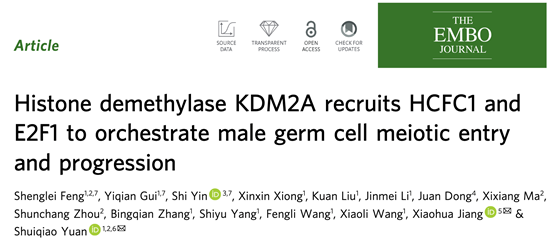A research team led by Professor YUAN Shuiqiao from the Reproductive Health Research Institute at Tongji Medical College, HUST, in collaboration with Dr. JIANG Xiaohua from the First Affiliated Hospital of the University of Science and Technology of China, has made significant strides in understanding the intricate mechanisms that govern the initiation and progression of meiosis in male germ cells. Their findings, published in The EMBO Journal, revealed the crucial role of the histone demethylase KDM2A in orchestrating the complex genetic events of meiosis.

Meiosis is a special phase in the development of germ cells, characterized by highly-ordered dynamic changes in gene expression and involvement of complex regulatory factors. The transition from mitosis to meiosis is pivotally regulated by retinoic acid (RA) signaling, which induces the expression of the meiotic regulator STRA8, essential for the development of spermatogonia into primary spermatocytes. While various factors are known to be involved in the process, the genetic regulation of meiotic initiation and progression remains not fully elucidated.
In their study titled “Histone demethylase KDM2A recruits HCFC1 and E2F1 to orchestrate male germ cell meiotic entry and progression,” the researchers discovered that KDM2A plays a vital role in the development of male germ cells. They found that KDM2A facilitates the recruitment of the transcription factor E2F1 and its cofactor HCFC1 to regulate the transcription of meiosis initiation and progression-related target genes, such as Stra8, Meiosin, Spo11, and Sycp1, thereby promoting the initiation of meiosis in spermatogonial cells and the completion of the entire meiotic process.
The research team, for the first time, observed that the germ cell-specific knockout of Kdm2a led to complete male infertility in mice, with the severely affected meiotic initiation and spermatogenesis being arrested at the zygotene stage. RNA-seq analysis indicated that KDM2A suppresses the expression of genes related to spermatogonial development and promotes the transcriptional activation of genes required for meiosis. Interestingly, CUT&RUN-seq analysis revealed that KDM2A effectively catalyzes the demethylation of H3K36me3 at its target gene regions in male germ cells, suggesting a novel function of KDM2A in these cells, distinct from its traditional role as an H3K36me2 demethylase in somatic cells.
Furthermore, the team discovered that KDM2A interacts with the transcription factor E2F1 and its cofactor HCFC1, recruiting them to the promoters of key meiosis genes to regulate their transcriptional expression, thus enabling spermatogonial cells to successfully enter meiosis and complete the entire process.
This study sheds new light on the role of KDM2A in germ cell development and hypothetically proposes a molecular mechanism by which histone modification enzymes and transcription factors synergistically regulate the transcription of key genes at the onset of meiosis. Notably, Professor Yuan Shuiqiao’s team also reported, in the July 2024 issue of Genome Biology, a novel molecular mechanism of m6A methyltransferase METL16-mediated gene selective splicing and translation efficiency regulation being involved in the meiotic initiation.
Conclusion and Future Perspectives: This research provides a new theoretical perspective for the clinical diagnosis of non-obstructive azoospermia patients caused by meiotic abnormalities. The findings are expected to pave the way for further research into the molecular mechanisms of meiosis and potential therapeutic targets for related fertility issues.
Paper link:https://www.embopress.org/doi/full/10.1038/s44318-024-00203-4
